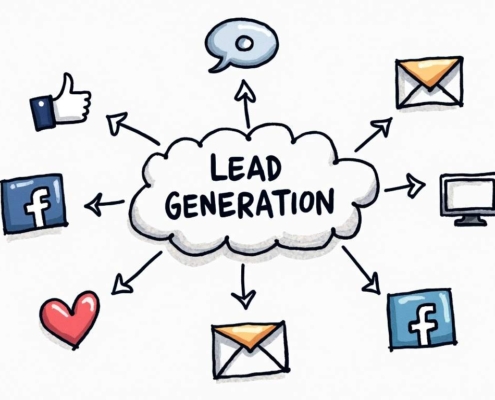

Virtual selling was trending upward before COVID-19. However, the pandemic made it more of a necessity than a business or prospect preference. Today, more and more companies are practicing virtual selling efforts to increase their B2B sales, and it’s not going anywhere any time soon.
A common mistake that sales teams make is that they approach virtual sales meetings the same way that they would approach in-person meetings—and we’re here to tell you that’s not the best approach. While the context of the meeting is typically the same, there are many different factors you must consider when virtually pitching prospects.
Throughout this blog, we’ll discuss the following topics:
Best Practices for Engagement in Virtual Meetings
Virtual meeting engagement can be more difficult to achieve than an in-person sales meeting. Here are some best practices for engagement in virtual meetings:
Present an Attractive B2B Sales Presentation
An eye-catching presentation is the first step to boosting the engagement of sales meeting participants and converting leads into customers. A B2B sales presentation—commonly referred to as a pitch deck—is a 10- to 20-slide presentation that provides a high-level overview of your company. These slides typically introduce your company, discuss the pain points that many businesses encounter, and identify your company’s products and services to offer them a solution.
Here are some key components to keep in mind when designing your B2B sales presentation:
- Only type down the most important topics: A text-heavy presentation is a snoozefest and risks turning off a client. Keeping copy short and sweet and breaking it up with compelling elements such as infographics, statistics, videos, and images keeps the prospect engaged.
- Keep it short and relevant: Each point you make should be short and relevant to the conversation. While sharing case studies enables prospects to see themselves as customers, it’s important to keep them quick and to the point while adding value.
- Don’t read directly from the pitch deck: When you keep key ideas short and relevant in the B2B sales presentation, you eliminate the risk of reading from the slide. Reading directly from the slide is not engaging to the virtual meeting participant and they will focus more on reading the slide than what you’re saying to them.
- Consistently engage with the prospect: A virtual B2B sales presentation is a two-way street. While a sales manager may be leading this presentation, consistent conversation is necessary to keep the prospect engaged. Engaging with the prospect could involve asking questions or integrating structural engagement activities, such as polls, analysis exercises, or quick get-to-know-you games.
Obtain High-Quality Video Conferencing Software
To have a productive online meeting with a prospect, you must have top-tier video conferencing software to ensure that you can pitch and present your products and services effectively. A reliable video conferencing software enhances the participant’s experience with your company and ensures they view your company in a positive light.
Since face-to-face meetings have become less common, your sales team must set virtual appointments to deliver their detailed sales pitches. While over-the-phone appointments are an option, you risk no-shows and not being able to read their body language to gauge their interest. By having high-quality video conferencing software, you can see the individual you’re pitching and have the opportunity to build a better relationship with them.
Frequently Ask Open-Ended Questions
As mentioned previously, asking open-ended questions is vital to engage meeting participants. This opens up the floor for conversation and encourages the prospect to talk more about their current situation and think about what they want out of a B2B partnership. Examples of open-ended questions to ask prospects during a virtual sales meeting could include:
- What are you hoping to accomplish within the next year?
- What are your must-haves, should-haves, and could-haves?
- Why are you looking at other opportunities?
Are prospects standing you up for your virtual meetings? Check out our blog to learn how to reduce no-show rates.
Things To Avoid When Hosting a Virtual Sales Meeting
Even if you have a fantastic pitch deck, reliable video conferencing software, and consistently ask open-ended questions, some aspects can make or break a sales presentation. Here are a few things to avoid when hosting a virtual sales meeting:
Poor Internet Connection
One of the most common issues when hosting a virtual sales meeting is a poor internet connection. Although this is typically out of your control, it’s a nuisance and could risk losing the interest and attention of the prospect. Before starting a virtual sales meeting, make sure your internet connection is reliable so the video quality is clear and the participant stays engaged throughout the meeting.
Distractions
Most of the people attending your virtual B2B sales presentation will listen to it through headphones, so any sound you make on your end is amplified. To eliminate distractions, it’s essential to do the following:
- Present your B2B sales pitch in a quiet room to eliminate external noise.
- Log in to the meeting at least half an hour early to ensure everything is prepared.
- Mute all of your notifications on your computer so you don’t have email or chat notifications popping up while you’re giving a pitch.
Ignorance
Nothing is worse than a sales rep who isn’t prepared and knows nothing about the business or industry they’re pitching. Before conducting your virtual B2B sales meeting, remember to do the following:
Practice and perfect your pitch. Having a complete understanding of the product or service you’re selling is crucial for an effective sales meeting. You should practice going through your pitch deck several times before you conduct a virtual pitch. In addition, it’s also important that you believe in what you’re selling to instill confidence in the prospect. Be confident and passionate about what you’re selling so the prospect is confident and passionate about your company too.
Research the industry and company you’re talking to. Before a virtual sales meeting, research the company you’ll be speaking with and the industry they serve. Not only will this impress them, but it can also help you deliver a more polished and impressive pitch because you can explain how your product or service will benefit their particular business.
Know how to run the program you’re using. If you say you’re late to a pitch because you were trying to figure out how to load or join the meeting, a prospect won’t be too impressed. This excuse isn’t good enough because knowing how to use the software is just as important as knowing the pitch. Knowing how to use a program is crucial because it shows that you have taken the time to prepare for the meeting.
How To Improve Your Sales Pitch for Virtual Selling
When pitching in a virtual sales meeting, you must be more cautious of what you say and how you say it. Here are some tips to keep in mind when trying to give an effective sales pitch:
Increase Your Tone and Inflection
Knowing what to say in a sales meeting is important, but so is the way you say it. Since the prospect has less opportunity to express non-verbal communication, you should increase your tone and inflection.
Your tone of voice is important in any sales pitch, but especially during a virtual pitch. Even if you’re using a video communication platform, a prospect isn’t able to see everything virtually. They won’t be able to see your head-to-toe appearance, and they won’t be able to read all of your body language. Therefore, your voice and how you deliver the pitch are what they’ll pay attention to the most.
Everyone has a natural voice inflection, but pay attention to the following things when you pitch:
- Change of pitch (downward inflection shows a prospect you’re confident with your message)
- Speed (talking fast is never good—slow down to show you want the prospect to listen carefully to what you’re saying)
- Volume (lowering the volume of your voice helps listeners feel relaxed)
To improve your inflection before a real pitch, practice speaking to yourself in the mirror or record your presentation and focus on areas for improvement.
Pace—Don’t Race
There is an art to a well-paced virtual sales presentation. If you use your time wisely, you can share a lot of information to impress the potential customer without overwhelming them. After a major sharing point, make sure to pause and allow the prospect to absorb everything that was just covered and open the floor up for questions. If a presentation is easy to follow with valuable and relevant information and doesn’t overwhelm the prospect, it could help you close the deal.
Be Personable and Relatable
When visiting a prospect’s office, there are plenty of conversation starters. Maybe they give you a short tour of the office, or perhaps you tell them something about your drive in just to break the ice. It’s harder to do this virtually. In a virtual meeting, greetings and introductions are fast, and the agenda rolls quickly.
Virtual meetings don’t have to be boring if you’re personable and relatable with the prospect. To create a more one-on-one experience, make sure the prospect can see you (and other presenters) the whole time, tell a personal anecdote, or crack a joke or two. If you’re good at reading people, you can easily gauge their interests and make sure you talk about something relevant to them.
During a face-to-face sales meeting, a prospect would normally build a connection through eye contact and body language. This is still true with virtual B2B sales presentations, but it can sometimes be more challenging to make a connection. When pitching virtually, make sure to use a webcam so they can see you and always look into the lens directly. This shows them that you’re talking to them as individuals and not just another company on a list of different business opportunities.
Prioritize the Buyer
Like any other sales process, you should always prioritize the customer. The prospect wanted to set up a virtual sales meeting to learn how you can benefit them and their day-to-day operations—not to hear you talk about how great your company is.
Every point you make in the virtual presentation should relate to the prospect and their current pain points. Remember not to pitch and sell them on products or services that they have little to no interest in; this could turn the client off and encourage them to partner with a competitor. Actively listen to the prospect’s wants, needs, and desires and integrate that into your virtual sales pitch.
Key Takeaways
Virtual sales meetings aren’t going anywhere soon, so it’s best to make the most of them to generate new business opportunities. While most of the context of the meeting stays the same, there are various best practices to follow and things to avoid to ensure you present the best sales pitch for your virtual sales meeting.
If you need help generating high-quality leads for your business or developing an eye-catching pitch deck for your virtual sales meetings, contact the sales reps at Abstrakt Marketing Group to get started!




